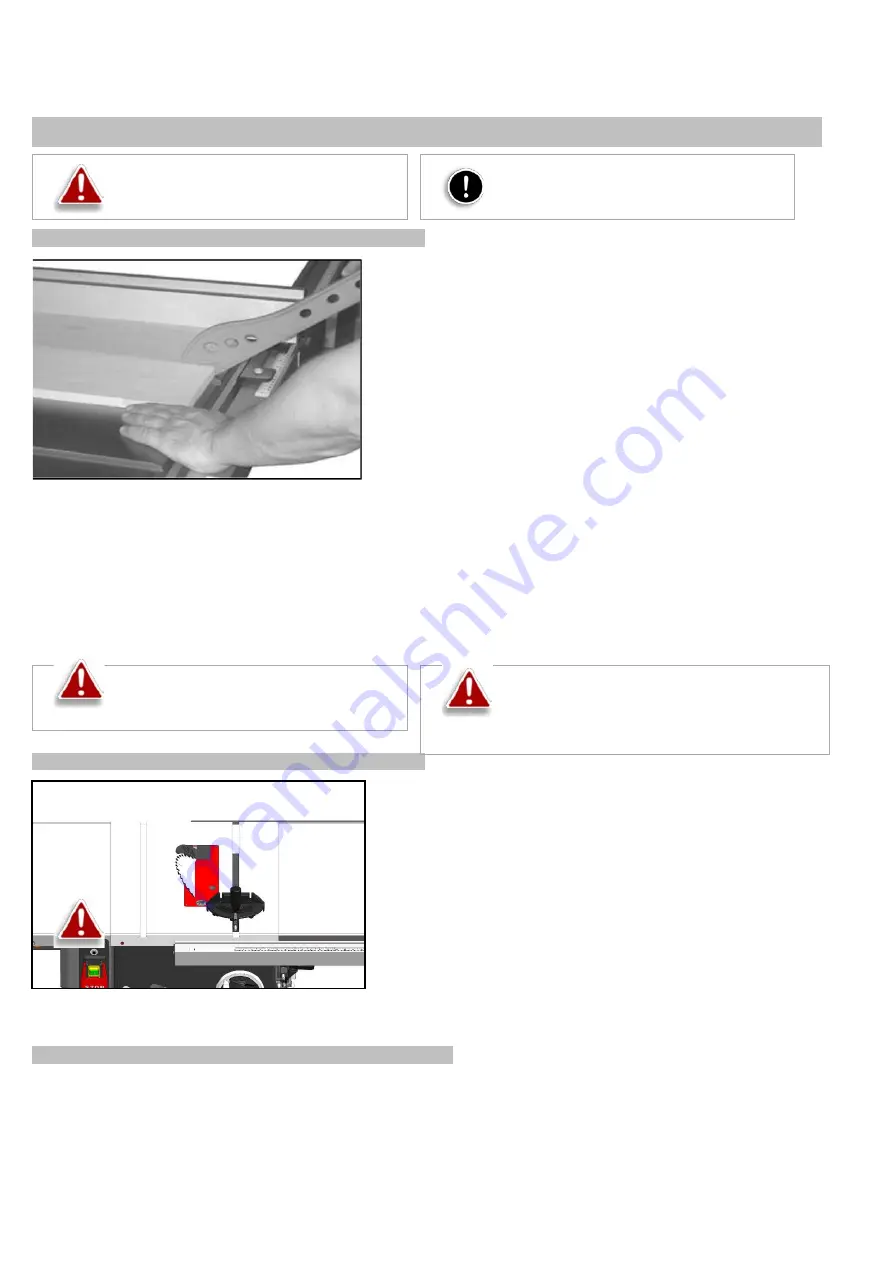
Fusion Tablesaw
27
Type of Cut
RIPPING
Cutting a wood plank or sheet of plywood lengthwise to reduce its width is
called “ripping”. To rip stock, hold the work with both hands pushing it into the
blade as well as firmly against the rip fence so that it is cut straight.
• Never rip or cut wood without using the fence or mitre gauge to guide it because the
stock could kickback.
• Always use the blade guard and riving knife assembly when cutting wood. The riving
knife prevents the saw “kerf” (the slit cut by the blade) from closing and binding the
blade, which can overload and/or stall the motor or cause the blade to lift and eject
the workpiece towards the front of the saw at very high speeds. The blade guard
keeps your fingers away from the blade and also reduces the amount of sawdust
flying free.
• Raise the saw blade only about 1/4" higher than the workpiece to be cut.
As you complete the rip, the wood will either remain on the table, tilt up to be caught on the end of the guard, or fall onto the floor (or outfeed table).
The waste part of the stock remains on the table to be removed only after the saw is stopped (unless it is large enough for immediate safe removal).
If the work to be ripped is narrow, it is safer to use a push stick, rather than the hands, to feed it into the blade Push sticks with non-slip grippers can be
purchased, but a shop-made one works just as well. When ripping extremely narrow stock that may not clear the width of the blade guard, or very thin
material such as paneling, which may slip between the underside of the fence and the table surface, a strip of wood as an auxi- liary guide can be
attached to the fence
BEVEL RIPPING
Bevel ripping is performed the same as ripping but with the saw blade set to an angle
not perpendicular with the table surface. To tilt the blade to the left, anywhere
between 0° and 45°. This is used most often when cutting bevels, compound miters
or chamfers.
After changing the bevel angle verify the alignment of the guard and splitter; make
sure there is clearance with the saw blade.
RIPPING SMALL WORKPIECES
Do not attempt rip cuts if the work piece is too small, as this will oblige you to place your hands too close to the blade and put you at serious risk of
injury. When ripping narrower widths; use a push block or a push stick in order to avoid placing hands near the blade.
Note:
This saw is only designed to cut
wood.
Warning:
Always wear safety glasses,
a respirator and hearing protection when
operating this machine
WARNING:
Keep the blade guard installed and in
the down position. Failure to do this could result in
serious personal injury or death.
WARNING:
Never reach in towards the blade while the
blade is still spinning! whenever a rip cut is completed,
turn off the saw and wait for the blade to come to a
complete stop before reaching in to remove the
workpiece or the waste material.
Summary of Contents for CEF236230175
Page 32: ...Fusion Tablesaw 32 Wiring Diagram Fusion F3 230V...
Page 33: ...Fusion Tablesaw 33 Parts Diagrams Fence Assembly...
Page 34: ...Fusion Tablesaw 34 MITRE GAUGE Blade guard...
Page 35: ...Fusion Tablesaw 35 Motor and Trunnion...
Page 36: ...Fusion Tablesaw 36 cabinet...
Page 37: ...Fusion Tablesaw 37 F3 Cabinet...
Page 45: ...45...
















































